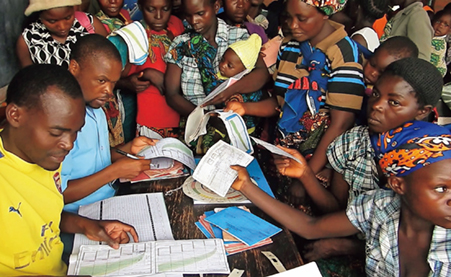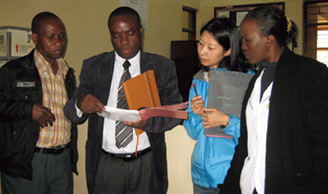Stories from the Field 01
Assisting with Malawi's Version of the Maternal and Child Health Handbook
– Activities to Improve Children's Growth Records on Health Passport

Health workers recording the weight in the newly produced health passport at a check-up (Photo: JICA)
Malawi, which is a landlocked country located in Southeast Africa, is an agrarian country where close to 80% of its 17 million people are involved in agriculture for main sustenance.
In Malawi, an infant health handbook called a health passport is given out to all new mothers who have given birth. This health passport is used to ensure children receive necessary medical care at the right timing and to keep important records for determining whether children are suffering from malnutrition. It also consists of spaces for recording the schedule and date of vaccinations and nutrition administration, the height and weight of children monthly from birth to age five, and hospital visits. This health passport is similar to the child section of Japan's maternal and child health handbook. As noted above, it is useful to identify children suffering malnutrition at an early stage and to ensure they receive proper care and treatment. However, a number of problems have arisen in Malawi through the use of this health passport.
“There were many mistakes in health passport records, which made it difficult to provide appropriate care based on the growth records of children.” This is the explanation, on the situation at that time, by Ms. Izumi Noda, a nurse dispatched to Malawi in 2016 as a Japan Overseas Cooperation Volunteer who worked on improving the health passport at the public health center of Mzimba District.
According to Ms. Noda, there were three major problems. First was the problem about mothers. Mothers did not take care of the health passport since they did not comprehend its meaning and importance. Although there are spaces on the cover of the health passport for the child's name and date of birth, in many cases, the front cover was completely ripped off and records including the child's name and vaccination history were lost. Also, there were many cases where a mother went to the hospital after some time since a home birth to receive a health passport. As a result, some mothers could not even recall the exact date of birth of their children. Without the exact date of birth, later records would also be inaccurate and in some cases stunted children were missed.

Ms. Noda examining operational usage of health passports with the Maternal and Neonatal Health Officer of the Ministry of Health of Malawi (Photo: JICA)
Second was the problem about health workers who work in a medical front after receiving short-term education. Their tasks are, for example, to write growth records in health passports. However, as many health workers did not understand how to enter records in the health passport or the importance of entering such information, they often entered the data in the wrong place. Also, there were many cases of health workers not showing up for work, so when 100 to 200 children came in at the same time for their check-up, the shorthanded staff sometimes entered incorrect information. Third was the problem about the health passport itself. The data entry in correct spaces was very hard to find, and moreover, the text and spaces were too small to work. This resulted in data entry mistakes.
Ms. Noda and her colleagues examined the situation of the health passports with the help of the local hospital and found that 97% of the health passports contained errors. Of these, 80% marked the wrong age in months. As a result, Ms. Noda and her colleagues became keenly aware of the need for a complete overhaul and settled on making the three changes below:
- Improvement of design of spaces for weight and height;
- Re-education and training of health workers; and
- Requests to mothers to take better care of their health passport.
Design improvement was pursued on a trial and error basis by five volunteers from Japan, focusing on modifications needed to prevent mistakes. Modifications included minor details, such as adding an all-new space for exam date and adding a thick line every five kilograms to ensure marks were correct. Also, they added a new space for the name and date of birth in the spaces of weight and height to ensure records could be traced even if the cover was missing. The newly produced health passport was introduced provisionally at five health facilities in Mzimba District, followed by a year-long field study beginning in May 2016.
During the field study, Ms. Noda and her colleagues gave health workers a briefing on the aim of the new design and trained them on how to enter data properly. They asked mothers who keep the health passport to take better care of the passport, including storing it in a plastic bag to prevent dirt or damage.
Finally, of the 7,036 new health passports given out, a total of 100 copies, 20 copies per each of five health facilities, were randomly collected for checking. After checking these, it turned out that mistakes on mark location and data entry had greatly been reduced. Also, there were positive reviews from health workers, saying, for example, that the new health passport was easier to use. As a result, the new health passport was officially adopted by the Ministry of Health of Malawi, and once the budget has been secured it will become standard nationwide.
Next Page >>
Main Text | Statistics and Reference Materials | Stories from the Field | Master Techniques from Japan to the World | ODA Topics
